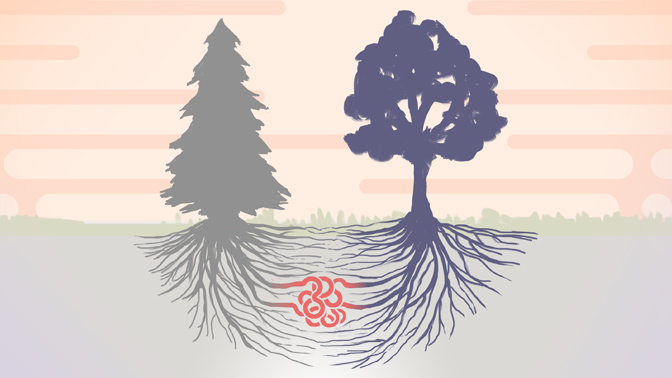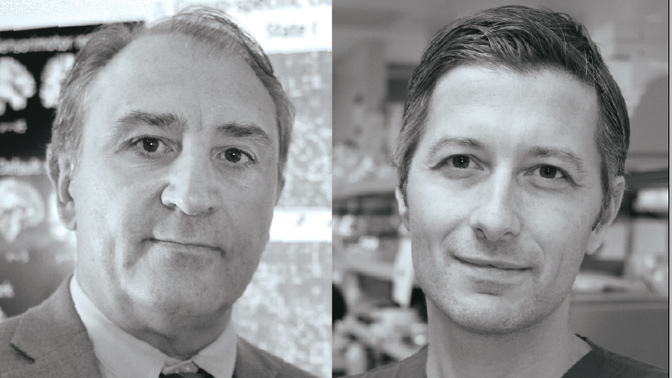
The Root Cause
Mutation of KRAS gene increases risk of hemorrhagic stroke
Roots grow to sustain trees. They split from the main stem and become progressively smaller as they burrow deeper into the soil to seek nutrients and water. Likewise, the arteries in our body grow and branch out into smaller blood vessels that feed and nurture our cells.
In rare cases this process is disrupted, and poorly formed blood vessels develop in the brain. These are referred to as brain arteriovenous malformations (BAVMs). These vessels are weaker and more likely to rupture and cause a stroke.
To get more insight into how BAVMs develop and why they are prone to rupturing or leaking, Dr. Ivan Radovanovic co-led a study with Dr. Jason Fish from the Toronto General Hospital Research Institute that examined the genetic content of BAVM tissue that was surgically removed from patients.
The researchers found that BAVMs from more than half the patients contained a mutated version of the KRAS gene, which is best known for its role in promoting the growth and survival of cancer cells. The altered gene was only located in the cells lining the BAVMs where it weakened the blood vessels.
“Fortuitously, there are cancer drugs available that dampen KRAS effects on cells. The next step will be to test whether these drugs can reverse the effects of mutated KRAS in experimental models of BAVMs,” says Dr. Radovanovic.
Nikolaev SI, et al. NEJM. 2018 Jan 18;378(3):250-261. Supported by the Canadian Institutes of Health Research (CIRH), Toronto General & Western Hospital Foundation (TGWHF), Novartis, the Canada Foundation for Innovation, the Natural Sciences and Engineering Research Council, the Swiss Cancer League, the European Research Council, the American Heart Association, the Canada First Research Excellence Fund, the Government of Ontario, the Brain Aneurysm Foundation and UHN’s Department of Surgery and Division of Neurosurgery. JE Fish holds a Tier 2 Canada Research Chair (CRC) in Vascular Cell and Molecular Biology. M Tymianski holds a Tier 1 CRC in Translational Stroke Research.
 Parkinson State of Mind
Parkinson State of Mind
Discovering alternate brain states that shed new light on Parkinson disease
Just as the appearance of trees can drastically change between two seasons—green and vibrant in spring to leafless and barren in the winter—new evidence suggests that the human brain can also exist in two different states.
This intriguing discovery was made after Dr. Antonio Strafella and his team used a highly sophisticated imaging technique called dynamic functional connectivity to visualize the brains of people with or without Parkinson disease.
The researchers discovered that the brain switches back and forth between two states: in the first state, the brain has sparse connections between cells that transmit information very efficiently; whereas in the second state, it has many connections that transmit information inefficiently.
By comparing the brain states of those with or without Parkinson disease, his team found that people with the disease were more likely to get stuck in the second state. Moreover, a shift in brain states from the first to the second was associated with more severe disease symptoms.
“We are the first to identify this second brain state,” says Dr. Strafella. “Our results indicate that the brain of a patient with Parkinson disease is not very efficient at sending information. Our next step is to figure out what role this process plays in the evolution of the disease.”
Kim J, et al. Brain. 2017 Nov 1;140(11):2955-2967. Supported by CIHR and TGWHF. A Strafella holds a Tier 2 CRC in Movement Disorders and Neuroimaging.

Genetic tests could improve diagnosis and treatment in patients with unexplained epilepsy
The brain is full of electrical activity. These electrical signals move from one cell to another, branching out to different parts of the brain and body where they control everything that we do.
In patients affected by epilepsy these signals misfire causing recurrent surges of abnormal electrical activity that lead to seizures. The cause of these surges is not well understood; however, researchers have shown that it can involve genetics, head trauma, developmental disorders, prenatal brain damage or infections.
Dr. Danielle Andrade recently examined the utility of a genetic test to help determine the cause of unexplained epilepsy in adults with an intellectual disability. The test detects a type of genetic alteration known as copy number variation (CNV), which has been linked to other diseases.
Dr. Andrade and her colleagues discovered that a high proportion of these patients carried rare CNVs that contributed to their epilepsy. Of the CNVs identified, eight were found to affect genes previously implicated in intellectual disability, autism and epilepsy.
“This study shows that genetic testing could provide clinicians with important information that may improve the diagnosis and treatment of epilepsy. Based on these findings, adults with epilepsy of unknown cause should be re-investigated with the modern DNA technologies available today,” says Dr. Andrade.
Borlot F, et al. JAMA Neurol. 2017 Nov 1;74(11):1301-1311. Supported by TGWHF, the Ontario Brain Institute and the Government of Ontario. AS Bassett holds a Tier 1 CRC in Schizophrenia Genetics and Genomic Disorders.

Krembil Research Institute (Krembil) researchers featured in the above stories are (L-R): Dr. Antonio Strafella, Krembil Senior Scientist; and Dr. Ivan Radovanovic, Krembil Scientist.




